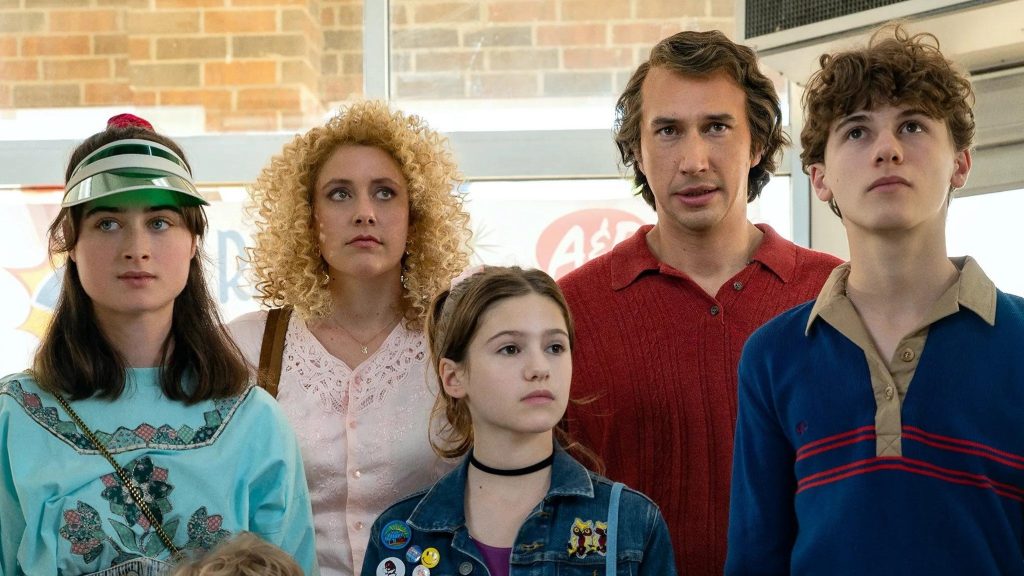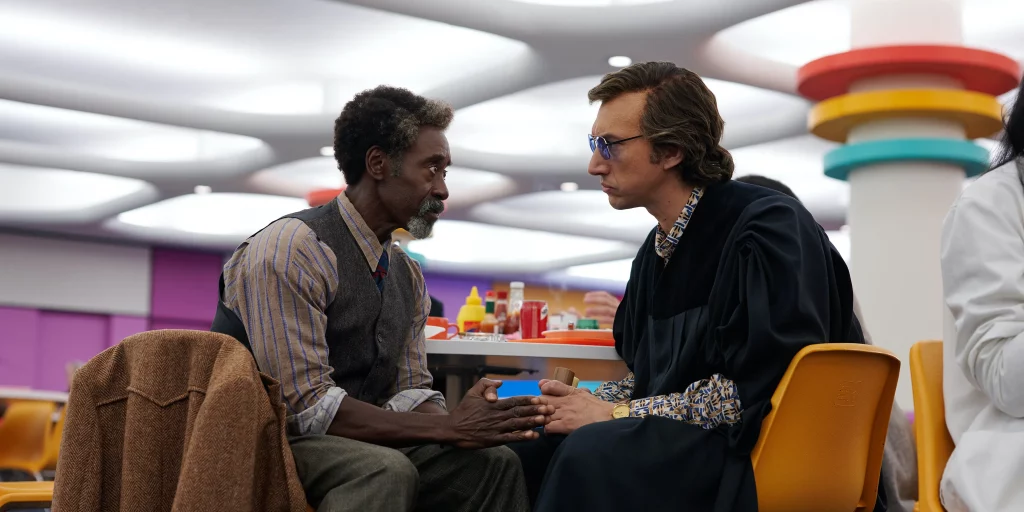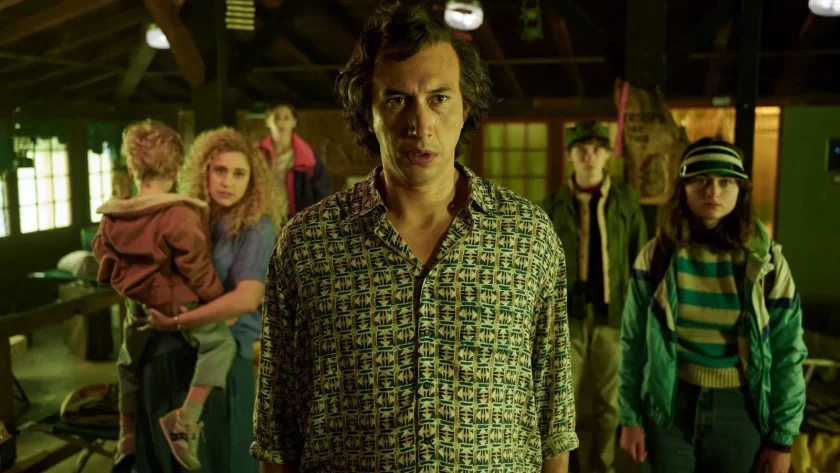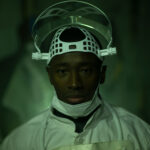The FilmSoc Journal is back for the the 79th edition of Venice film festival, with critic Aryan Tauqeer delivering a look at the hits and misses of the 2022-23 season.
◯ Warning: this review contains spoilers.
Aryan Tauqeer reviews Noah Baumbach’s latest collaboration with Adam Driver and Greta Gerwig in disaster-comedy White Noise.
Noah Baumbach’s latest tale of familial strife (and his first adaptation) opens with a montage of distinctly American impulses- the juxtaposition between external and internal release of psychosexual repression. The car crash, an internal channeling of a primal desire for both amalgamation into a collective event and the achieving of some degree of separation from the hive mind of traffic, is described in such terms by an academic, to the befuddlement of a lecture hall either unable or unwilling to comprehend the possibility that they could ever walk willingly into the maws of nigh-certain death. These images are succeeded by a simultaneous montage of Hitler’s addresses to the German public, described in a tone of hushed, ecstatic reverence by a professor. As disparate as they may seem, these images are linked by their ability to create spectacles so entrancing that they create the conditions for death- from that of two drivers rendered limp and lifeless by the collision of their cars, to six million marched into furnaces of genocide. It is this conceptualization of the spectacle as an agent of mass hysteria that guides the family in White Noise through crises both apocalyptic and inconsequential.

The film’s conduit for this exploration of spectacle is Jack Gladney (Adam Driver), an acclaimed professor of Hitler Studies with a particular fondness for the Fuhrer’s style of public address and an even greater fondness for drawing a similar amount of attention from his students. His slavish devotion to the study of the dictator is telegraphed through his imitation of his mannerisms- whilst seemingly sitting in as a guest on one of his colleagues’ seminars, he gradually siphons attention from his coworker to himself, pacing about the room with a leather jacket clumsily strung over his back as a cape. The camera tracks him pacing around a circular theater as a figure of magnitude in spite of his pathetic attempts at maintaining poise by pushing his bright blue shades up the bridge of his nose.
In a similar vein, the lens hinges on Driver as a lynchpin of stability in carefully composed tableaus of domesticity-that is, until the the Airborne Toxic Event disrupts the rhythm of Jack’s everyday life, plunging the film into a prolonged panic attack composed of a series of extended one-take shots and dolly zooms. A traffic jam halfway through the film reduces the looming behemoth that is Jack to a mere speck of flabby skin, powerless against the elements themselves turning against him in a compositions that recall Kamiński’s collaborations with Spielberg. This is not the only manifestation of Spielberg’s influence in the film-indeed, its centering of a family’s internal conflicts against the backdrop of an alien “invasion” draws heavily from Close Encounters of the Third Kind, whilst the paranoia amongst refugees of this shapeless calamity is a clear analogue to that depicted in War of the Worlds. Even the uneven, schmaltzy melodrama of the film’s third act is characteristic of Spielbergian emotion.

It is precisely this heightening of male impotency to nigh-apocalyptic scale that White Noise is most effective in conveying. However these montages of crises after crises lead to the film’s ambition in adapting a DeLillo novel that has been termed ”unfilmable” softening the incisiveness of Baumbach’s acerbic, blunt style of dialogue. This is most clearly evident in the film’s transition from paranoia thriller to a reflection on the universal disintegration of marriage, where Baumbach’s concerns with the inability of deep-rooted domestic conflict to be truly “resolved” is clearly at odds with the demands of DeLillo’s prose. The jarring quality of this shift is not without warrant- as one of Jack’s many eccentric colleagues, Murray (Don Cheadle) remarks after the former encounters reason to ponder upon his mortality, a defining feature of the postmodern American lifestyle is the omnipresence of déjà vu. The repetition of catastrophe upon catastrophe, therefore, is less a misstep than a deliberate, if not entirely successful, attempt by Baumbach to encapsulate the eye-gougingly dull mundanity that the novel’s characters are entrapped within. Take the repetition of Jack’s nightmare, another sequence that acts as an outlier in Baumbach’s oeuvre for its insurrection of primal fear. As Jack lies next to his wife, Babette (Greta Gerwig), he notices a writhing mass next to him, in place of his otherwise comically acquiescent spouse. As the mass rises and the blanket tightens to form the shape of a faceless being, looming above Jack’s petrified husk, the “dream” ends. Without any indication of a clear entry or departure from a fugue state, then, this repeated sequence acts as a microcosm for the film’s thesis-that is, that the American experience is a waking nightmare interrupted only by the warm yellow glow of supermarket aisles, luring a post-Reagan generation of consumers as a moth to a flame.
Though Baumbach’s adaptation is restrained by the demands inherent to its existence, flashes of the director’s trademark verbal acuity disrupt the imposition of a novelistic structure upon the film- particularly when Driver’s recognizable aggressiveness as a performer is undermined by his being overwhelmed by the Armageddon-esque disaster that he refuses to recognize as such. When the vast cloud of the Event finally descends upon the Gladney family, Jack remarks, in memetic fashion, that running out of gas is an impossibility because “there’s always extra”, to which one of his 5 disparate stepchildren snaps “How can there always be extra?”. In light of the events of the past 2 years, such assurances and rebukes ring with eeriness, as does the glance Jack and Babette share afterward- momentary it may be, but it conveys far more in its silence than the film’s jilted, droll commentary on consumerist culture (set to the tune of LCD Soundsystem) does. It is in these moments that White Noise seems to momentarily escape the spectre of DeLillo’s novel, before becoming subsumed by it yet again as an adaptation chained by its own particular déjà vu.
White Noise will be released in select cinemas from 25th November, 2022 and will premiere on Netflix on 30th December, 2022. Watch the trailer here:




